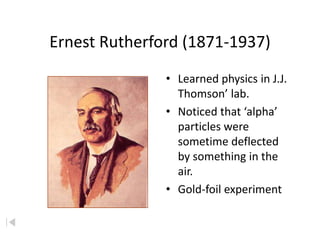
Atomic history day #2 1
- 1. Ernest Rutherford (1871-1937) • Learned physics in J.J. Thomson’ lab. • Noticed that ‘alpha’ particles were sometime deflected by something in the air. • Gold-foil experiment
- 2. Rutherford ‘Scattering’ • In 1909 Rutherford undertook a series of experiments • He fired (alpha) particles at a very thin sample of gold foil • According to the Thomson model the particles would only be slightly deflected • Rutherford discovered that they were deflected through large angles and could even be reflected straight back to the source Lead collimator Gold foil particle source
- 3. Rutherford’s Apparatus beam of alpha particles radioactive substance fluorescent screen circular - ZnS coated gold foil Dorin, Demmin, Gabel, Chemistry The Study of Matter , 3rd Edition, 1990, page 120
- 4. What he expected… California WEB
- 5. Because he thought the mass was evenly distributed in the atom. - - - - -
- 6. Because, he thought the mass was evenly - - distributed in the atom - - - - - - - - - - - - - - - - - - - - - - -
- 7. What he got…
- 8. Density and the Atom • Since most of the particles went through, the atom was mostly empty. • Because the alpha rays were deflected so much, the positive pieces it was striking were heavy. • Small volume and big mass = big density • This small dense positive area is the nucleus California WEB
- 9. The Rutherford Atom n+ Zumdahl, Zumdahl, DeCoste, World of Chemistry 2002, page 57
- 10. Niels Bohr • In the Bohr Model (1913) the neutrons and protons occupy a dense central region called the nucleus, and the electrons orbit the nucleus much like planets orbiting the Sun. • They are not confined to a planar orbit like the planets are.
- 11. Bohr Model Planetary model After Rutherford’s discovery, Bohr proposed that electrons travel in definite orbits around the nucleus.